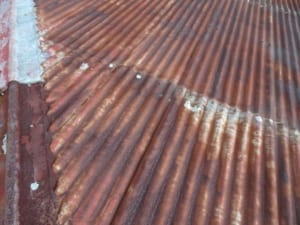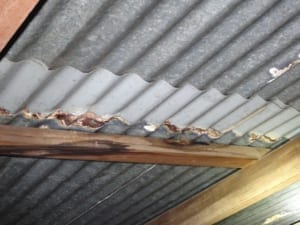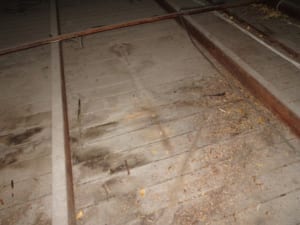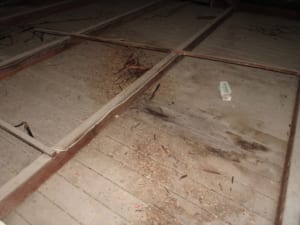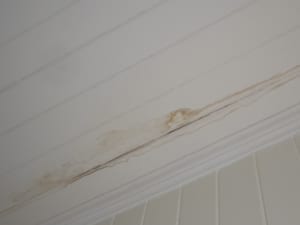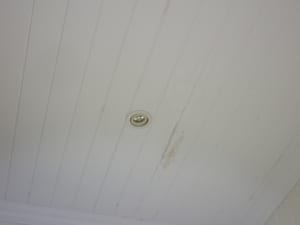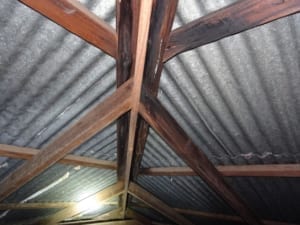Damage from rusted roof, and associated problems it has caused from many years of leaking.
Damage from rusted roof. QBIS.
Why access and use of photos are so important.
- To show a buyer the extent and severity of the problem that could not be achieved without gaining access to the roof exterior.
- Photos bring the problems to the client.
- To achieve a better understanding as to the extent and severity of the problem.
- To help a prospective buyer make a more accurate informed decision on whether to proceed with a purchase.
Or to consider renegotiating the purchase price to allow costs of rectification.
Rusted roof sheets:
Short Zincalume sleeves have been fitted between the galvanised roof sheets, this will cause corrosion between the different products.
Ceiling lining damage (roof interior):
Some damage to the timber ceilings, but not significant enough to warrant replacing of the linings. Look at the following photos for the other side.
Ceiling lining damage (house interior):
As long as the source of the leaking has been rectified, in most cases the linings would only require sanding and possibly some filler, before repainting.
Roof batten damage:
Although these roof battens are rotten and require replacing the expense would not great. Some rot has also occurred to parts of the rafters but not enough to require replacing them.
Some roofing contractors will only screw the roof battens to the rafters, this is not enough!
The following are just a few suggestions on what can be done by you roofing contractor when replacing the roof sheeting:
- Attach metal strapping across the rafters where they are attached to the top plate of the walls.
- Metal strapping across the ridge-beam from rafter to rafter.
- If possible, fit threaded cyclone bolts from the top wall plate to the sub-floor structure.
- Fit hold down bolts from the stumps to the bearers.
- Fit more support to the roof structure, off the internal walls or a roof beam over the walls.
- Place a hanging beam in the roof area from wall to wall to allow more support to any sagging ceiling joists (if sagging significantly).
- Secure any sagging ceiling battens that may have come away from the ceiling joists.
- Fit vermin proofing where necessary (vermin can cause damage to electrical wires).
- Fit insulation below the roof sheeting, better still also to the ceilings.
- Fit roof vents, eaves must also be vented for vents to work effectively. Do not fit spinning roof vents (they are prone to leaking) vents do not have to spin for them to work, just a pipe with a cap on top. Hot air rises from natural convection, as it rises it will be displaced with cooler air drawn from the eaves.
These are only retrospective suggestions to use as a guide only and are by no means a guarantee of fully securing your house in all adverse weather conditions. You must seek an expert opinion for advice on what would be required in your particular location and for your type of building regarding the required appropriate securing of your house.
- I would strongly recommend consulting your local Council for local knowledge and advice regarding securings for roof tying down.
- Fitting of insulation below the roof sheeting when replacing the old sheeting is always a good idea as it cannot be done later.
- Do not fit silver foil building paper on its own below the roof sheeting, it serves no insulation purpose and condensation is highly likely to occur between them, this may cause premature corrosion.
- Make sure a blanket of insulating material with silver foil attached with the foil to facing down with only the insulation being in contact with the roof sheeting.


